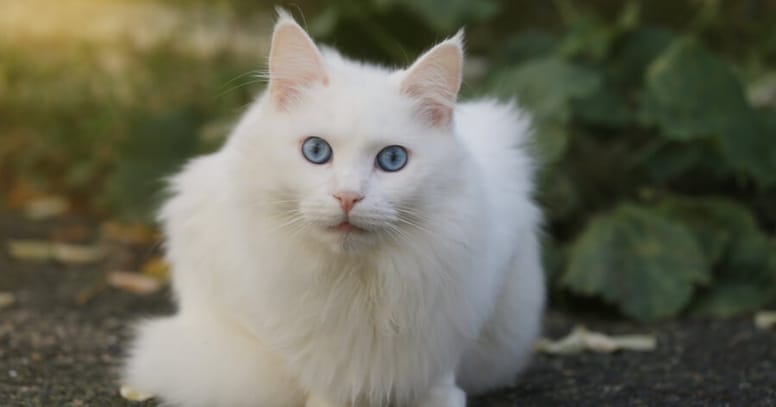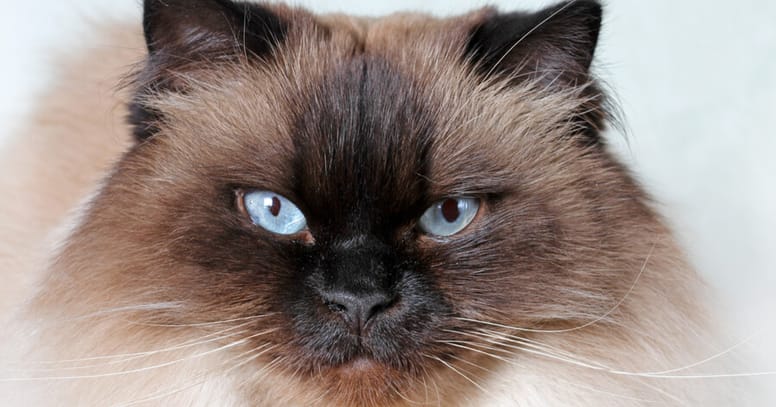Blue eyes in cats are usually caused by an absence of pigment. All kittens have blue eyes when they are born as the development of eye pigmentation doesn’t happen until the kittens reach around six weeks old, when the production of melanin finally kicks in.
Some cats will carry their blue eyes on into adulthood. For pure breeds with blue eyes, particularly pointed breeds, this is due to a recessive albinism gene. For other cats, it is due to an extra gene that also acts to block the coat colour. This means that blue-eyed moggies don’t just have beautiful sapphire coloured eyes, they will also be white. Blue eyes are actually quite rare in adult cats, so it's a treat to see them! If you're a fan of beautiful blue eyes, then you may be wondering what kind of cats have blue eyes? Well look no further! Check out our list of the most beautiful blue-eyed cat breeds!
Siamese

Siamese cats hail from Thailand, previously known as Siam! At the time, they were aristocratic cats, but we'd argue they still are today. Tall and sleek, they are the models of the cat world! They are extremely playful, so make wonderful family pets. However, meowing musn't bother you, as these are extremely vocal cats who want to talk all the time!
Persian

Persians are one of the oldest cat breeds in the world, hailing from Persia - modern day Iran. Not all Persians have blue eyes, but the white ones do. And with their eyes being particularly large, this makes for a stunning feline! Persians are one of the most popular breeds in the world due to their affectionate and laid-back personalities. They get along with everyone and anyone, as long as cuddles are involved.
Balinese

The Balinese started to appear randomly in Siamese litters in the early 20th century. Essentially, these cats are long-haired Siamese! They are extremely intelligent and have an inquisitive nature, which means you'll have to cat-proof your house to keep your feline out of trouble. In fact, Balinese are recommended for 'advanced' cat owners who are willing to train them!
Javanese

Javanese are almost identical to Balinese, the only difference being that they come in a much larger variety of coulours. The Javanese is elegant and slender, despite having a very muscular body. Javanese are good for people who like to keep their homes clean, as their silky coats are well known for being low-shedding and easy to groom. They bond very well with all members of the family, so they make great pets.
Turkish Van

Turkish Vans originated from, you guessed it, Turkey! These cats can have blue or amber eyes, sometimes one of each! Their most incredible feature is that they are fascinated by water - in fact, they love to swim! Turkish Vans are very active cats who are also quite independent, so they're not for owners who want to cuddle for hours on the sofa.
Turkish Angora

Also from Turkey, the Turkish Angora has been popular among royal families all around the world for centuries. And it's not hard to see why! They are absolutely stunning. Angoras are most well-known in their white-coated, blue-eyed variety, but they are bred in different coat colours as well. They are good-natured cats who make good fits for families.
Himalayan

Himalayans are a mix between a Persian cat and a Siamese cat. Their blue-point colouring means they have piercing deep blue eyes much like the Siamese, but they have the long coat and flat face of the Persian. Himalayans are friendly, get along with children and other animals, and are one of the most easy-going cat breeds in the world.
Ojos Azules

Ojos Azules literally means 'blue eyes' in Spanish. The breed got its name from its beautiful vivid blue eyes, which appeared naturally among feral cats in Mexico. Though this breed is undeniably beautiful, very little is known about it due to its rarity. It is hoped that the breed will be further developed in the coming years - that incredible shade of blue deserves to be admired by many more!
Birman

A breed originally from India, Birmans are now known all over the world for their calm dispositions and lovely natures. In fact, Birmans love attention and affection, so they're a perfect match for people who want a cuddly cat. Believe it or not, their long silky coats don't mat easily, so they're also a good choice for people who want a wash-and-wear type pet.
There are many more blue-eyed cat breeds out there, including the Tonkinese, the Ragdoll, and the Snowshoe cat! However, tabby, tortoiseshell and white moggies can also have blue eyes.
Why are white cats with blue eyes often deaf?
In his 1868 work, “The variation of domesticated animals and plants”, Charles Darwin wrote: “If white cats have their eyes blue, they are almost always deaf”. In fact, while not all white cats with blue eyes are born deaf, many of them are. It’s estimated that around 60% to 80% of white cats with two blue eyes are likely to be deaf. Cats with just one blue eye are between 30 and 40% likely to be deaf.
Melanin affects the colour of a cat’s coat and also the cochlea in the inner eye. If the masking gene prevents the development of melanin, the cochlea can degenerate soon after the kitten is born and the cat will be deaf permanently. This masking gene can sometimes be responsible for white felines with blue eyes. Therefore, if a cat has blue eyes, they are more likely to be deaf.
There can be other reasons for cats being white and other genes can affect eye colour. Siamese, for instance, tend to have blue eyes but the white colour is caused by a different gene. If a cat has Siamese in their ancestry, it may look white with blue eyes, but if the blue eyes are caused by the Siamese gene, that cat may very well have perfect hearing.
There’s something particularly striking about gazing upon big, bright blue eyes. But when it’s framed by a feline face, whether a rare breed or even just a common domestic moggy, the blue eyes become even more captivating. It may all be down to pigmentation or simple ancestry but blue eyes will always stand out the most.

